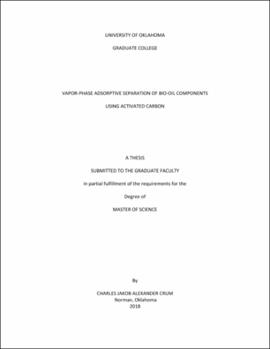| dc.description.abstract | Biofuels processes involve the upgrading of components produced by fractionation of cell wall biopolymers. However, the fractionation is not selective to high-value components, and separation is necessary. The use of adsorptive separations for biofuels mixtures avoids oligomerization reactions caused by thermal separations. Activated carbon strongly adsorbs phenol derivatives but weakly adsorbs acetic acid, which makes it a strong candidate for biofuels separations. This work investigated the adsorption characteristics of several representative compounds onto activated carbon, and probed the suitability of activated carbon for biofuels separations processes. An activated carbon packed bed was used for chromatography studies, and a modified TGA/DSC was used to study adsorption capacity and thermodynamics. It was found that phenolic compounds such as m-cresol likely adsorb via a combined hydrogen bonding and π-π stacking mechanism to surface sites such as quinones, as well as less strongly to flat carbon ring sites via π-π stacking alone and to oxygenated sites via hydrogen bonding alone. In contrast, aromatic compounds such as benzene adsorb via π-π stacking only, and light oxygenates such as acetic acid adsorb via hydrogen bonding only. The adsorptive capacity found for m-cresol, the representative phenolic target for adsorptive separations, was between 12.0 and 24.6 g/kg adsorbent, or between 0.111 and 0.227 mol/kg adsorbent. This work also finds a characteristic breakthrough curve for m-cresol on activated carbon, and designs a scaled-up adsorptive separation process including adsorbent regeneration. | en_US |
